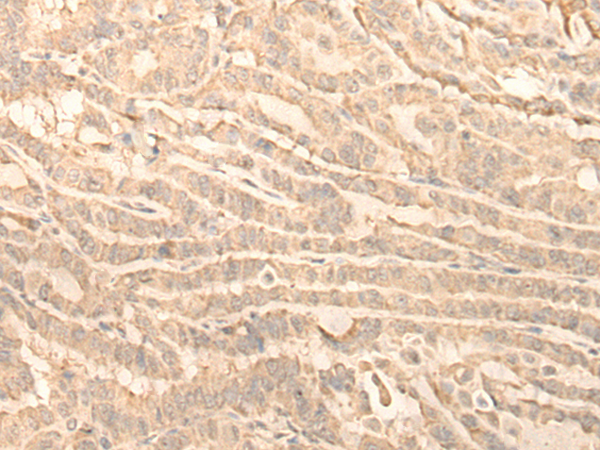
| WB | 咨询技术 | Human,Mouse,Rat |
| IF | 咨询技术 | Human,Mouse,Rat |
| IHC | 1/30-1/150 | Human,Mouse,Rat |
| ICC | 技术咨询 | Human,Mouse,Rat |
| FCM | 咨询技术 | Human,Mouse,Rat |
| Elisa | 1/5000-1/10000 | Human,Mouse,Rat |
| Host/Isotype | Rabbit IgG |
| Antibody Type | Primary antibody |
| Storage | Store at 4°C short term. Aliquot and store at -20°C long term. Avoid freeze/thaw cycles. |
| Species Reactivity | Human, Mouse, Rat |
| Immunogen | Fusion protein of human RNF146 |
| Formulation | Purified antibody in PBS with 0.05% sodium azide and 50% glycerol. |
+ +
以下是3篇与RNF146抗体相关的代表性文献摘要:
1. **《RNF146 is a poly(ADP-ribose)-directed E3 ligase that regulates axin degradation and Wnt signaling》**
- 作者:Zhang Y et al.
- 摘要:研究发现RNF146通过识别PARsylated(聚ADP核糖化)靶蛋白(如Axin),介导其泛素化降解,从而调控Wnt/β-catenin信号通路。该研究利用特异性抗体验证了RNF146与Axin的相互作用及功能关联。
2. **《RNF146 inhibits excessive autophagy by modulating ubiquitination of TSC1 in Parkinson's disease》**
- 作者:Li X et al.
- 摘要:揭示RNF146通过泛素化自噬调控蛋白TSC1.抑制过度自噬以保护多巴胺能神经元。研究使用RNF146抗体进行免疫沉淀实验,证实其在帕金森病模型中的神经保护机制。
3. **《RNF146 promotes tankyrase-mediated degradation of 3BP2 in cancer metastasis》**
- 作者:Wang H et al.
- 摘要:报道RNF146通过促进Tankyrase介导的3BP2蛋白降解,增强肿瘤细胞迁移和侵袭能力。该研究通过RNF146抗体敲低实验,证明其在癌症转移中的潜在治疗靶点价值。
注:以上内容为文献核心发现的概括,非原文摘要直译。如需完整文献信息,可通过PubMed或Google Scholar搜索标题获取原文。
RNF146 (Ring Finger Protein 146) is an E3 ubiquitin ligase involved in the ubiquitin-proteasome system, playing a critical role in regulating cellular processes such as DNA repair, Wnt/β-catenin signaling, and stress response. It recognizes and binds to poly(ADP-ribose) (PAR)-modified substrates, a hallmark of DNA damage or oxidative stress, and promotes their ubiquitination and subsequent degradation. Key targets include Axin, a negative regulator of Wnt signaling, and PARP1. a DNA repair enzyme. Dysregulation of RNF146 has been linked to neurodegenerative diseases, cancer, and metabolic disorders, highlighting its importance in maintaining cellular homeostasis.
Antibodies targeting RNF146 are essential tools for studying its expression, localization, and molecular interactions. They are widely used in techniques like Western blotting, immunoprecipitation, and immunofluorescence to investigate RNF146's role in pathways such as Wnt signaling or PAR-mediated stress responses. Researchers also employ these antibodies to explore how RNF146 modulates pathological conditions, including its dual role in promoting cancer cell survival (via degrading tumor suppressors) or enhancing neuronal death (through excessive protein clearance). Validated RNF146 antibodies help dissect its regulatory mechanisms, including post-translational modifications and substrate specificity, offering insights into therapeutic targeting of PAR-dependent ubiquitination pathways.
×